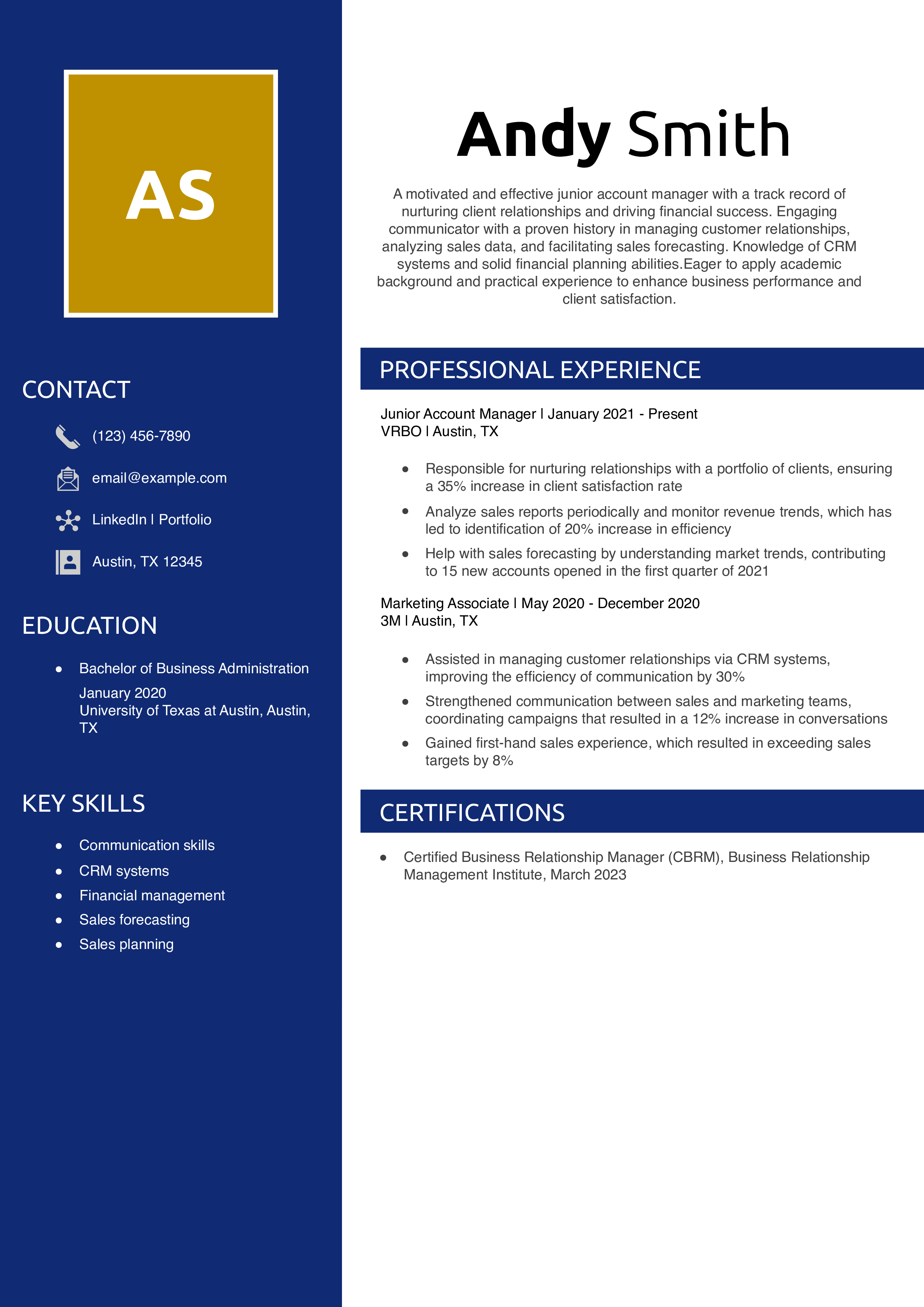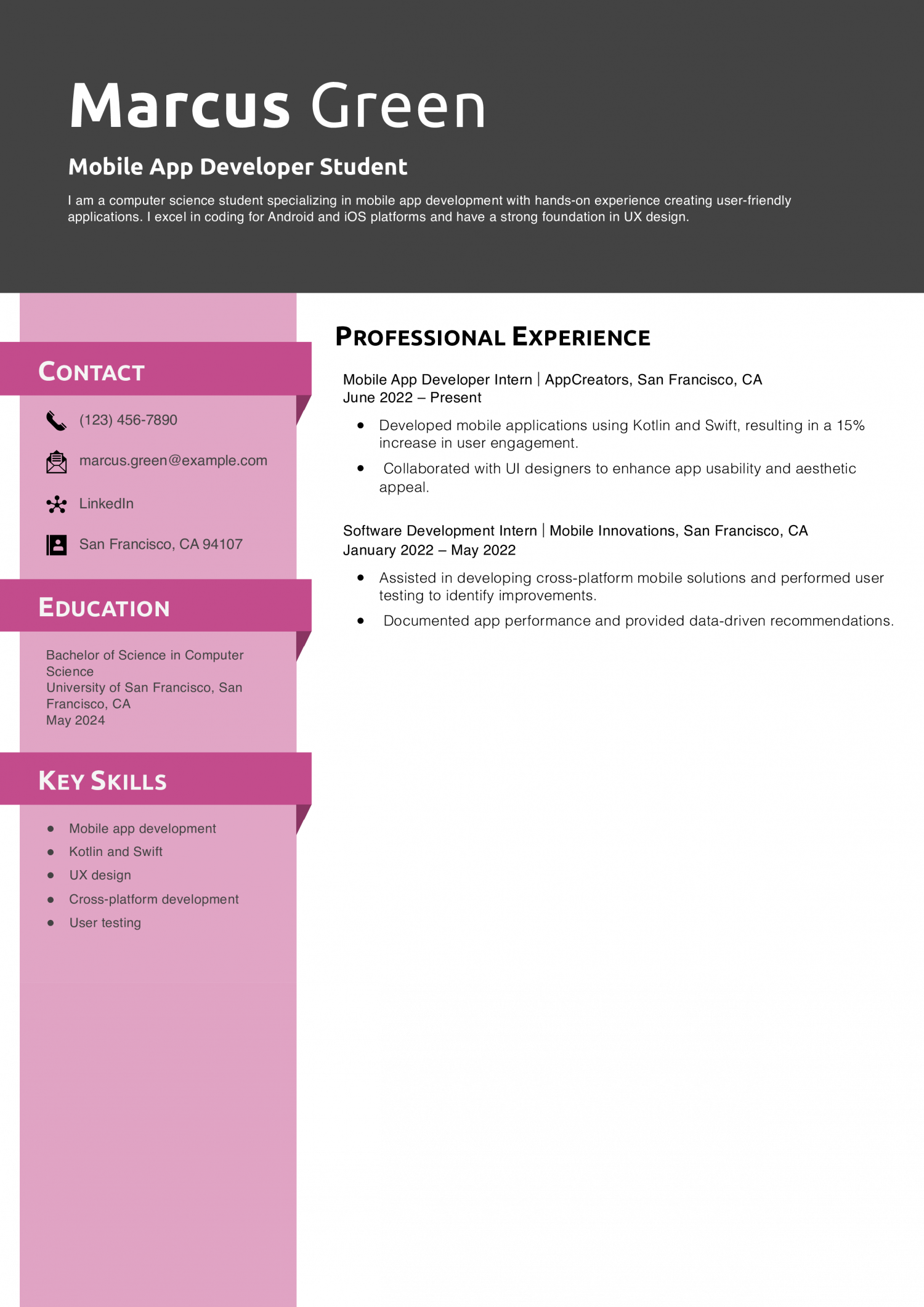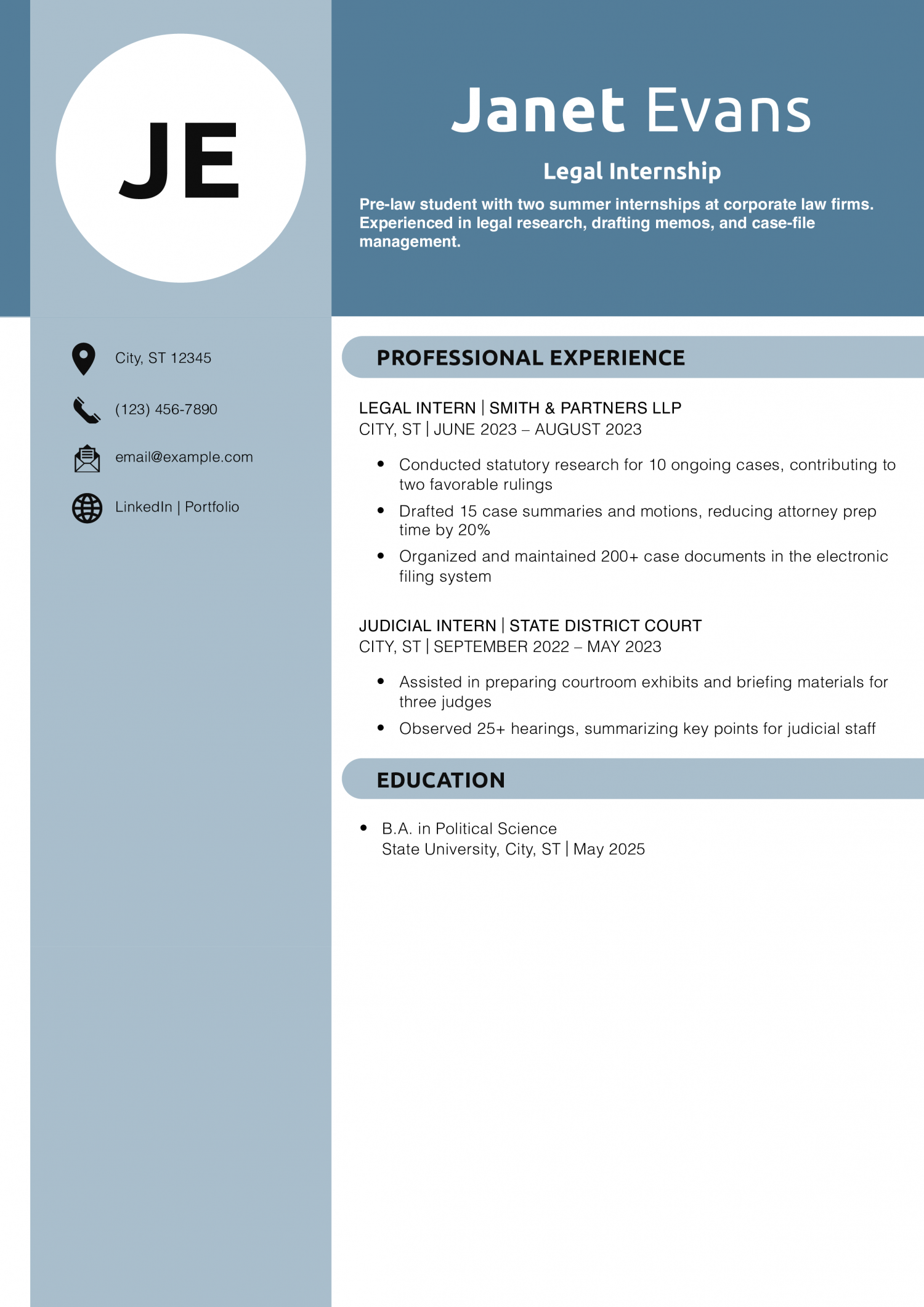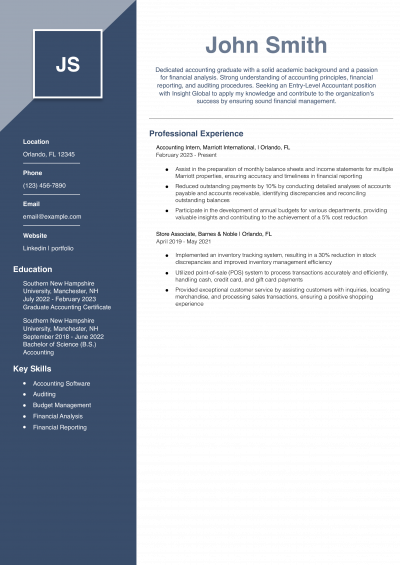Use our robust app to create a customized template specific to your needs and goals.












Use our robust app to create a customized template specific to your needs and goals.
Most Popular Functional Resume Templates
Entry-Level Resume Template
This resume template is designed with students and early-career professionals in mind. It uses a clean, approachable layout and a centered name header for high readability. The left-hand sidebar includes a photo and a short profile section that gives personality and context to academic and internship experience.
Best for:
Format and styling details:
- Two-column layout with a friendly design, featuring a headshot and summary in the sidebar
- Right column showcases experience, education, and certifications in a clear top-to-bottom flow
- Modern sans-serif fonts and section spacing ensure readability across print and digital formats
- Ideal for job seekers with limited experience who want to highlight leadership potential and technical support skills
- Built to work well with student achievements, part-time roles, and university-based jobs

Modern Resume Template
This resume template combines bold style with a beginner-friendly structure, perfect for students or junior developers looking to break into mobile app development. The contrasting color blocks and organized sections help balance visual flair with professional clarity, making it easy for hiring managers to assess your potential.
Best for:
Format and styling details:
- Two-column layout with a magenta-accented sidebar for quick access to contact info, education, and skills
- Name and title featured in a bold, high-contrast header with a focused profile summary
- Content area presents internships and technical contributions using concise, results-based bullet points
- Works well for showcasing coding skills, collaborative development, and UI/UX understanding
- Ideal for new grads or students with internship or project-based experience

Clinical Resume Template
This resume template uses a clean, clinical-inspired layout with gold accents to project professionalism and reliability. Ideal for students or recent graduates in allied health fields, it emphasizes certification, hands-on rotations, and adherence to safety protocols. The sidebar design keeps essential qualifications front and center.
Best for:
Format and styling details:
- Two-column layout with gold sidebar for contact information, education, and skills
- Bold name block and professional title sit at the top for immediate recognition
- Clear “About Me” section replaces a traditional summary for student and certification-focused resumes
- Experience section uses concise bullet points with quantifiable outcomes
- Designed to highlight clinical rotations, patient care skills, and adherence to protocols

Simple Resume Template
This resume template is designed to highlight volunteer service and health care support experience in a clear, compassionate format. With structured section blocks and calming green accents, it emphasizes education, skills, and hands-on contributions to community wellness. The balanced layout is ideal for candidates seeking entry-level roles or continuing education in health care.
Best for:
Format and styling details:
- Two-column layout with green section headers and icons for a polished, accessible look
- Left column features education and skills with strong visual cues for quick scanning
- Right column highlights experience and certifications using clean bullet formatting
- Ideal for showcasing internships, volunteer work, and support-based roles in community health
- Supports role-specific impact statements and measurable contributions

Law Student Resume Template
This resume template is tailored for aspiring legal professionals and pre-law students, with a balanced, structured design that communicates clarity and professionalism. The slate blue header and sidebar give it a refined tone, while the layout is ideal for highlighting internships, research, and document preparation.
Best for:
Format and styling details:
- Two-column layout with soft blue sidebar for contact details and location
- Bold name header with job title and a concise summary for early-career legal candidates
- Clean content formatting with space for detailed internship experience and case-related work
- Ideal for showcasing research, case drafting, and courtroom support experience
- Great for students applying to law school, clerkships, or entry-level legal assistant roles

Hospitality Resume Template
This resume template offers a friendly, approachable layout perfect for customer-facing roles. The warm color palette and clean structure make it easy to follow while still showcasing relevant experience in hospitality, dining, and guest services. A standout header and sidebar keep essential info accessible for quick review.
Best for:
Format and styling details:
- Two-column layout with a burgundy sidebar for contact information and education
- Name and job title stand out in a bold header with a clear, introductory summary
- Experience section uses concise bullet points to highlight service speed, teamwork, and guest care
- Ideal for showcasing part-time, school-year, or seasonal jobs in food service
- Simple, ATS-friendly structure that helps first-time job seekers make a confident impression

Professional Resume Template
This resume template is designed for emergency services professionals and health care volunteers. Its bold, teal-accented sidebar adds visual structure while reinforcing clarity and calm — ideal for medical and community-first response roles. The layout focuses on training, certifications, and service-based impact.
Best for:
Format and styling details:
- Two-column layout with a deep teal sidebar for contact info, skills, and location
- Name and summary sit at the top, setting a confident tone with emphasis on reliability and experience
- Experience section highlights hands-on fieldwork, training, and patient care contributions
- Great for certified professionals and volunteers in health and safety roles
- Ideal for entry-level or community-based candidates who’ve supported clinical teams or public events

College Resume Template
This resume template is designed specifically for college students who are building professional experience while completing their education. The clean layout, soft color palette, and clear organization make it easy to showcase internships, campus leadership, and academic background without overwhelming the page.
Best for:
Format and styling details:
- Two-column layout with an easy-to-read structure ideal for limited experience
- Left-hand sidebar neatly organizes contact info, education, and key skills in one place
- Right-hand content area gives space to describe relevant jobs, volunteer work, or on-campus involvement
- Bold name header and short introductory title help employers understand the candidate's focus quickly
- A great fit for resumes that need to highlight education first while still showing initiative and measurable results

Combination Resume Template
This college resume template is built to help students in technical fields like engineering clearly present internship experience, project work, and core competencies. The bold design and color-block sections bring structure and focus to a resume that may still be growing, making it ideal for job fairs, co-op applications, or graduate program submissions.
Best for:
Format and styling details:
- Two-column layout with gold-accented sections that organize content without overwhelming the page
- Left sidebar highlights contact details, LinkedIn, education, and technical skills in a compact format
- Right-hand section includes internship or lab-based experience and relevant certifications
- Strong header design with job title and summary makes it easy to identify field of study and goals
- Clean bullet points emphasize quantifiable achievements and technical impact

Functional Resume Templates
A resume is a vital component of your job search. It acts as your first line of communication with hiring managers, explaining how your past success has prepared you to take on a new role.
But if you lack experience or are new to a field, how can you create an effective resume?
Whether you’re transitioning careers, looking for your first job, or returning to work after time away, a functional resume will help you present a cohesive professional identity. This unique layout serves a specific purpose: to demonstrate that you meet job requirements based on your skills instead of a progressive work history.
Once you understand what an employer is looking for, you can tailor a functional resume to show how you meet their needs. The focal point of this resume format is a summary of transferable skills. Within this section, you focus on impressive achievements made using relevant technical and interpersonal abilities or proficiencies.
For a complete guide to structuring your document, check out our How to Make a Resume guide, which details best practices for a functional resume format.
What makes a functional resume template?
When you think of a classic resume template, the reverse-chronological format is often what first comes to mind: a large work history section followed by supporting details. The functional resume is a bit different.
Instead of presenting a progressive work history, your abilities take the lead. Its unique structure is designed to demonstrate that you have the key skills to excel. The sections are similar to a standard resume, just arranged a little differently:
The majority of a functional resume will be dedicated to a “Relevant Abilities” section. No matter the job, you’ll likely include both hard and soft skills. Go into greater detail than you would in a traditional skills list. This section does the heavy lifting, with multiple bullet points describing past accomplishments achieved as a result of your skills.
When selecting a functional resume template, remember that readability is still your number one priority. Hiring managers must be able to quickly scan through your document and capture why you’re the best fit for the job. Placing your skills near the top of the page will help with this, so look for layouts that prioritize a large skills section.
Choose a professional template that’s clean and simple. Although using multiple colors and fun graphics may look nice, avoid anything that could take away from your content. Look for minimalist designs that make your skills the focus.
Discover diverse layout ideas on our Best Resume Formats page. The examples provided illustrate various resume format styles — including those ideal for a functional approach.
When to pick a functional resume template
Functional resumes aren’t a common choice for most job hunters, but they have their place in special circumstances. Generally speaking, a functional resume should be used when the standard reverse-chronological format doesn’t represent your qualifications well. These are the top reasons it would be beneficial to pick a functional resume template:
- To call attention to specific skills and competencies
- To minimize gaps in employment
- To better tailor your unrelated experience to a new job
- To demonstrate the transferable potential
- To present skills gained from volunteering or hobbies
How to get the most out of this template
The functional format is all about maximizing your professional skills and proficiencies. To craft a strong functional resume, approach your writing with a clear strategy. The writing tips from a professional resume writer below will help you put together a great functional resume:
- Align with the job description: While any good resume will be tailored to the unique needs of the employer, this is especially true for a functional format. Understand the job’s core competencies and match up your own skills. Then, mirror the language used in the job posting by including keywords and phrases organically throughout your resume.
- Start with a strong profile: The first paragraph of your resume is often a profile or summary of your key strengths and unique value proposition. This section should be brief but impactful, highlighting your most relevant skills, experiences, and accomplishments. Focus on strong, action-oriented language to capture the employer’s attention.
- Emphasize relevant skills: You won’t have room to list and expand upon every one of your skills. Instead, choose the three most relevant to the job. Determine which ones to include by studying the job description and identifying how your own abilities align with the job requirements.
- Use specific examples: Instead of simply stating, “Helped customers and processed transactions” when describing a skill like customer service, be specific. For example, “Served an average of 50 customers and processed over $5,000 in transactions per day.” Using numbers and action verbs will show the scope of your impact and responsibilities.
- Curate your work history: Professional experience takes a backseat in a functional resume, so only list your latest and most relevant jobs, keeping the descriptions short and concise. Similar to describing your skills, use examples that relate to the job and include numbers to illustrate the scope of your work.
Frequently Asked Questions: Basic Resume Templates
Create a "Relevant Skills'' section and list a few bullet points under each skill. Each point should highlight achievements you've made using those abilities. Use numbers like percentages, performance indicators, and monetary figures to show tangible outcomes. Hiring managers should be convinced you've had plenty of experience using the capabilities required for the job.
If you're unsure about which skills transfer well from one job to the next, O*NET OnLine has a digital tool called "Related Activities Search" that compares work activities across multiple occupations. It also has a large database of common technology skills and soft skills you can browse to better understand the full spectrum of job duties for any occupation.
The functional format is best utilized in the rare instance when a chronological or combination resume doesn't flatter or represent you well. If you're worried that a lack of experience could affect your chances of landing an interview, a functional resume may be the way to go. Individuals in the following circumstances would benefit from this resume style:
- Recent graduates
- Entry-level job seekers
- Career changers
- Professionals with employment gaps
- People with an unconventional work history
A functional resume format emphasizes your skills and achievements over a traditional job history, making it ideal for career changers, recent graduates, or those with gaps in employment. By focusing on relevant competencies, you can craft a resume summary that highlights what you bring to the table without getting lost in chronological details. Many functional resume examples showcase your transferable skills and measurable results, allowing hiring managers to quickly assess your potential. This approach tailors your application to the job description, ensuring that key skills stand out and increasing your chances of landing an interview.
The functional format can be beneficial in certain situations. However, it also has drawbacks to be aware of. In some instances, a functional resume can trigger negative perceptions. For example, some hiring managers may assume that you're trying to hide that you've been job-hopping or lack any relevant experience.
Also, certain sectors, such as law, academia, and government, often place an emphasis on a traditional chronological approach. A functional format may confuse and put off employers, calling into question your credibility. Before deciding on a functional resume template, ensure it's the right fit for your target industry and desired role.
In a functional resume, your resume summary is crucial because it sets the tone for your application. Start with a concise statement that highlights your core strengths and relevant skills, focusing on how these competencies match the job requirements. Include quantifiable achievements and specific examples from your professional background that illustrate your impact. This summary should encapsulate your career highlights in a few impactful sentences, ensuring that hiring managers immediately understand your value. Tailoring your resume summary for each role is essential for making a strong impression and demonstrating your fit for the position.
More Resume Templates
Looking for a different resume template? Check out this list:
Check out Related Examples
Resume Templates offers HR approved resume templates to help you create a professional resume in minutes. Choose from several template options and even pre-populate a resume from your profile.


















